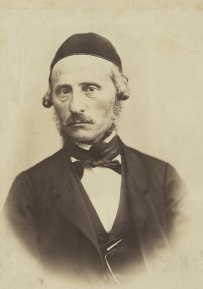Hamagid
 | |
| Type | Weekly newspaper |
|---|---|
| Founded | 1856 |
| Political alignment | Zionism |
| Language | Hebrew |
| Ceased publication | 1903 |
| Headquarters | Lyck, East Prussia |
| Country | East Prussia |
| Free online archives | Online, searchable Hamagid editions from the Historical Jewish Press |
Hamagid (Hebrew: הַמַּגִּיד; lit. 'the Declarer'),[1] also known after 1893 as Hamagid LeIsrael (הַמַּגִּיד לְיִשְׂרָאֵל),[2] was the first Hebrew language weekly newspaper.[3][4] It featured mostly current events, feature articles,[5] a section on Judaic studies,[6] and, in its heyday, discussions of social issues.[7] Published between 1856 and 1903,[3] it first appeared in Lyck, East Prussia and targeted Russian Jews, but was soon redistributed all over Europe and the Jewish world.[3] Although it only had a peak circulation of 1,800 copies, it's primarily remembered as beginning the modern day Hebrew language press.[3] It is hard to estimate its true readership, as in its era one copy would pass through many hands.[2]


Hamagid carried global and Jewish news in Hebrew, either translated, or as original reporting.[1] It was also the first newspaper to publish op-eds in Hebrew.[1]
The founder and first editor of Hamagid was Eliezer Lipman Zilbermann (1819 – 1882).[7] He is credited with bringing the social issue of the agunot to the forefront of reader's minds, and he made the issue one of the most important topics in the paper.[7] A frequent contributor to the weekly was Moses Vita Ascarelli; under the pen name, "Emet le-Ya'akov," he wrote articles on the condition of Italian Jews under Pope Pius IX.[8] From the 1860s, the paper "fervently" supported resettlement of the Land of Israel for a combination of religious and nationalistic reasons, making the paper an early nucleus of the Zionist movement.[3]
David Gordon (1831 – 1886),[1] formerly deputy editor, became editor in 1880, and his son became deputy editor.[2] He held the position of editor until his death in 1886.[3][7] After the death of his father, Dov Gordon continued as editor until 1890,[7] until Yaacov Shmuel Fux took over, who edited between 1890 and 1903[7][2] and whose sole focus was on cultural and political issues, and not social issues as previous editors had focused on, in the footsteps of Zilbermann.[7]
Hamagid moved twice: first to Berlin in 1890, then to Kraków in 1892.[3] After moving to Kraków, its readership declined, partly due to censorship by Russian authorities.[2] It finally closed in 1903.[3] In its twilight years, its de facto editor was Shimʻon Menaḥem Lazar,[3] although Fux kept the title of editor until the end.[7]
Post-1892, Hamagid found itself largely supplanted by other Hebrew language newspapers like Ha-Melitz and Ha-Tsfira.[3]
See also[edit]
- Lev Levanda
- Der Beobachter an der Weichsel, the first Jewish newspaper
References[edit]
- ^ a b c d Paul R. Mendes-Flohr; Jehuda Reinharz (1995). The Jew in the Modern World: A Documentary History. Oxford University Press. pp. 240–. ISBN 978-0-19-507453-6. Retrieved 18 June 2016.
- ^ a b c d e "Ha-Magid". National Library of Israel. Tel Aviv University. Retrieved 19 June 2020.
- ^ a b c d e f g h i j Holtzman, Avner; Fachler, David (27 August 2010). "Magid, Ha-". The YIVO Encyclopedia of Jews in Eastern Europe. Retrieved 19 June 2020.
- ^ Alexander Orbach (1980). New Voices of Russian Jewry: A Study of the Russian-Jewish Press of Odessa in the Era of the Great Reforms, 1860-1871. BRILL. pp. 38–. ISBN 90-04-06175-4. Retrieved 18 June 2016.
- ^ Cowley Lecturer in Post-Biblical Hebrew Fellow in Modern Hebrew Literature Oxford Center for Postgraduate Hebrew Studies Glenda Abramson; Glenda Abramson (1 March 2004). Encyclopedia of Modern Jewish Culture. Routledge. pp. 705–. ISBN 978-1-134-42865-6. Retrieved 18 June 2016.
- ^ Ronald L. Eisenberg (2006). The Streets of Jerusalem: Who, What, Why. Devora Publishing. pp. 155–. ISBN 978-1-932687-54-5. Retrieved 18 June 2016.
- ^ a b c d e f g h Greenspoon, Leonard J. (2016). Mishpachah. Purdue University Press. pp. 90–91. ISBN 978-1-61249-469-2.
- ^ Lippe, Ch D. (Chayim David) (1881). Ch. D. Lippe's bibliographisches Lexicon der gesammten jüdischen Literatur der Gegenwart und Adress-Anzeiger. University of California. Wien, D. Löwy.
